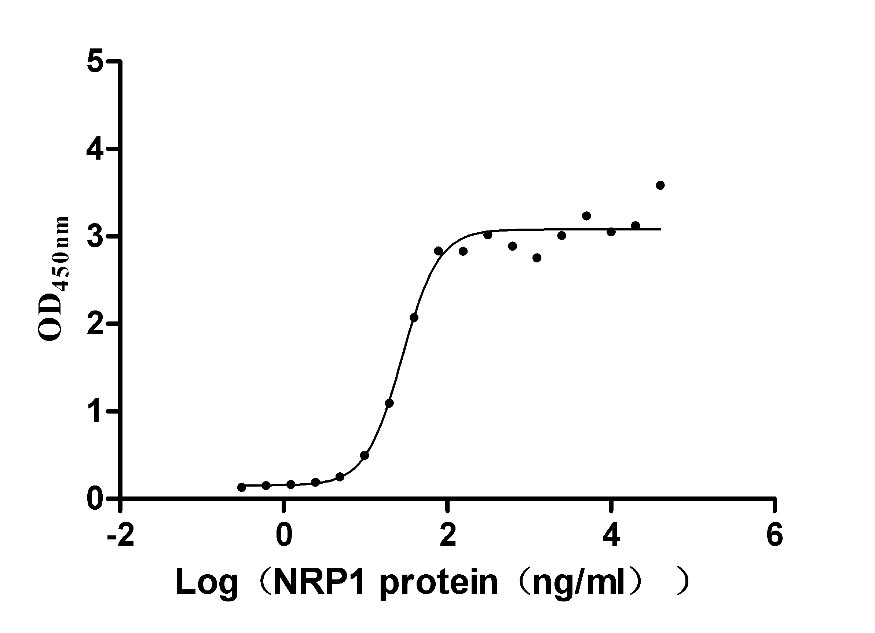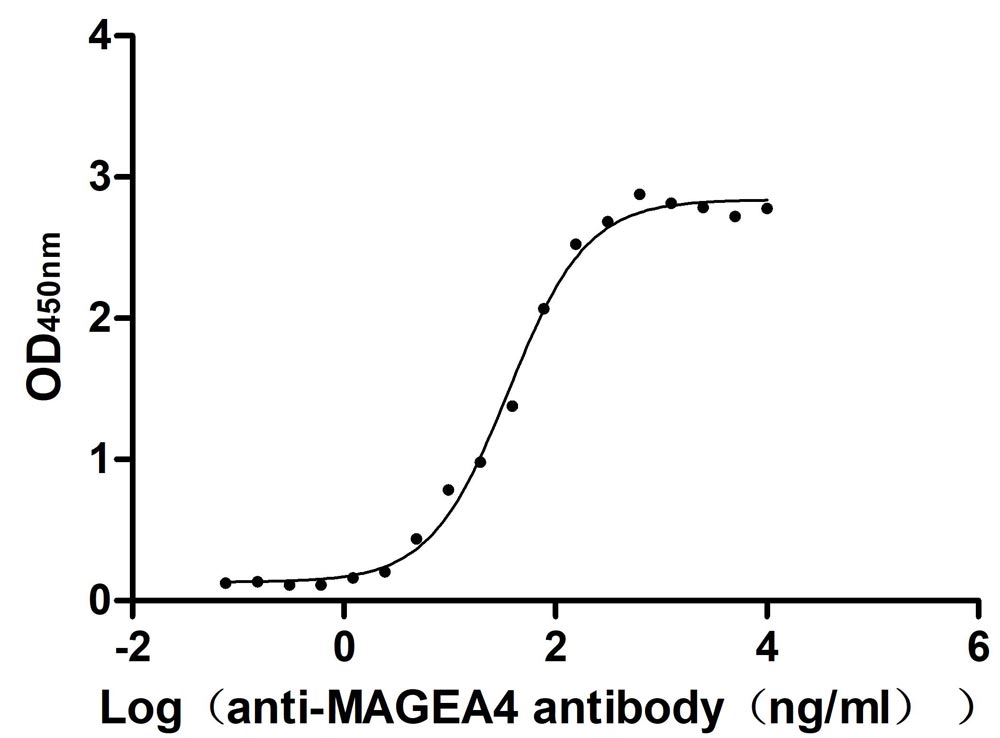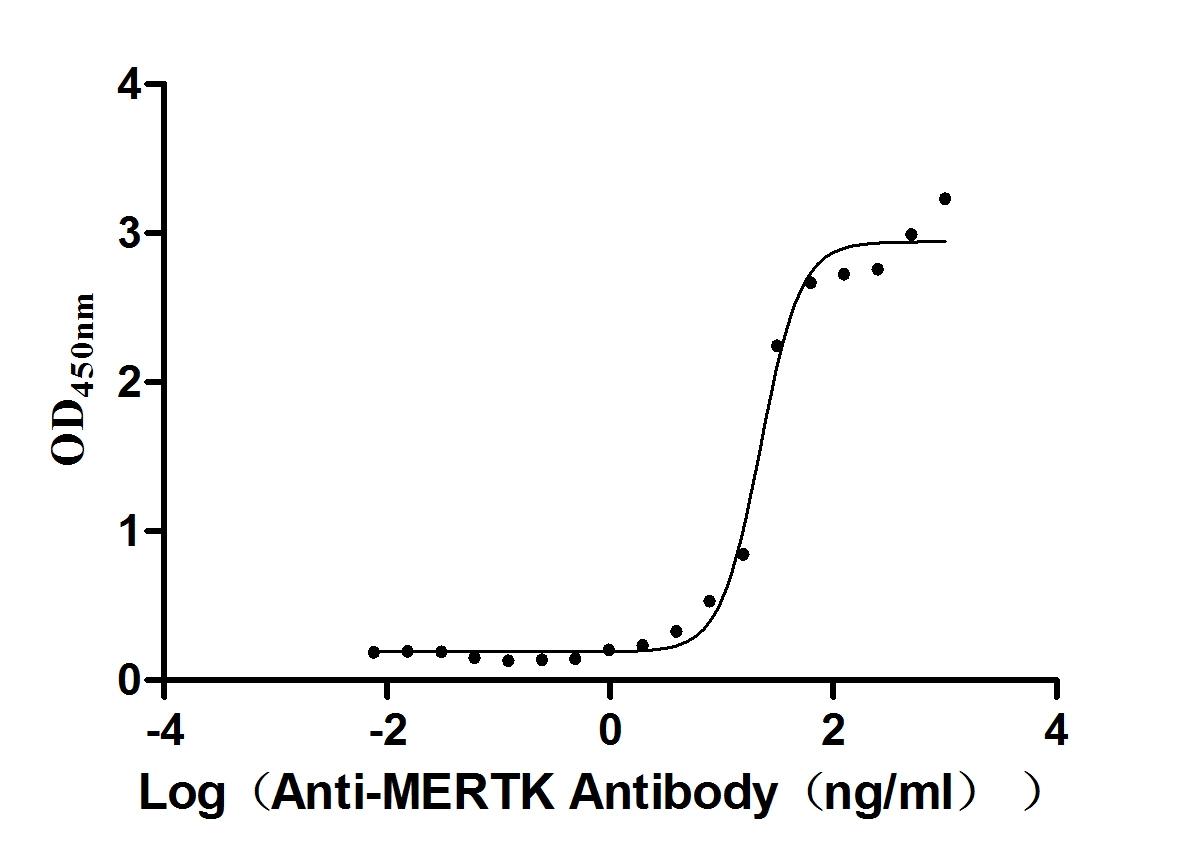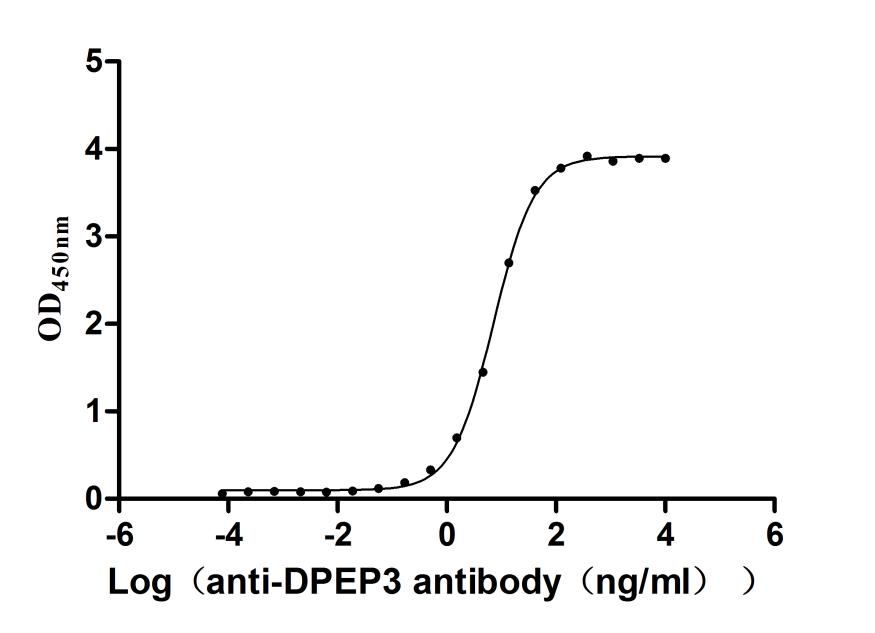Recombinant Mouse Epoxide hydrolase 2 (Ephx2)
-
中文名称:小鼠Ephx2重组蛋白
-
货号:CSB-YP007735MO
-
规格:
-
来源:Yeast
-
其他:
-
中文名称:小鼠Ephx2重组蛋白
-
货号:CSB-EP007735MO
-
规格:
-
来源:E.coli
-
其他:
-
中文名称:小鼠Ephx2重组蛋白
-
货号:CSB-EP007735MO-B
-
规格:
-
来源:E.coli
-
共轭:Avi-tag Biotinylated
E. coli biotin ligase (BirA) is highly specific in covalently attaching biotin to the 15 amino acid AviTag peptide. This recombinant protein was biotinylated in vivo by AviTag-BirA technology, which method is BriA catalyzes amide linkage between the biotin and the specific lysine of the AviTag.
-
其他:
-
中文名称:小鼠Ephx2重组蛋白
-
货号:CSB-BP007735MO
-
规格:
-
来源:Baculovirus
-
其他:
-
中文名称:小鼠Ephx2重组蛋白
-
货号:CSB-MP007735MO
-
规格:
-
来源:Mammalian cell
-
其他:
产品详情
-
纯度:>85% (SDS-PAGE)
-
基因名:Ephx2
-
Uniprot No.:
-
别名:Ephx2; Eph2; Bifunctional epoxide hydrolase 2 [Includes: Cytosolic epoxide hydrolase 2; CEH; EC 3.3.2.10; Epoxide hydratase; Soluble epoxide hydrolase; SEH); Lipid-phosphate phosphatase; EC 3.1.3.76)]
-
种属:Mus musculus (Mouse)
-
蛋白长度:Full length protein
-
表达区域:1-554
-
氨基酸序列MALRVAAFDL DGVLALPSIA GAFRRSEEAL ALPRDFLLGA YQTEFPEGPT EQLMKGKITF SQWVPLMDES YRKSSKACGA NLPENFSISQ IFSQAMAARS INRPMLQAAI ALKKKGFTTC IVTNNWLDDG DKRDSLAQMM CELSQHFDFL IESCQVGMIK PEPQIYNFLL DTLKAKPNEV VFLDDFGSNL KPARDMGMVT ILVHNTASAL RELEKVTGTQ FPEAPLPVPC NPNDVSHGYV TVKPGIRLHF VEMGSGPALC LCHGFPESWF SWRYQIPALA QAGFRVLAID MKGYGDSSSP PEIEEYAMEL LCKEMVTFLD KLGIPQAVFI GHDWAGVMVW NMALFYPERV RAVASLNTPF MPPDPDVSPM KVIRSIPVFN YQLYFQEPGV AEAELEKNMS RTFKSFFRAS DETGFIAVHK ATEIGGILVN TPEDPNLSKI TTEEEIEFYI QQFKKTGFRG PLNWYRNTER NWKWSCKGLG RKILVPALMV TAEKDIVLRP EMSKNMEKWI PFLKRGHIED CGHWTQIEKP TEVNQILIKW LQTEVQNPSV TSKI
-
蛋白标签:Tag type will be determined during the manufacturing process.
The tag type will be determined during production process. If you have specified tag type, please tell us and we will develop the specified tag preferentially. -
产品提供形式:Lyophilized powder
Note: We will preferentially ship the format that we have in stock, however, if you have any special requirement for the format, please remark your requirement when placing the order, we will prepare according to your demand. -
复溶:We recommend that this vial be briefly centrifuged prior to opening to bring the contents to the bottom. Please reconstitute protein in deionized sterile water to a concentration of 0.1-1.0 mg/mL.We recommend to add 5-50% of glycerol (final concentration) and aliquot for long-term storage at -20℃/-80℃. Our default final concentration of glycerol is 50%. Customers could use it as reference.
-
储存条件:Store at -20°C/-80°C upon receipt, aliquoting is necessary for mutiple use. Avoid repeated freeze-thaw cycles.
-
保质期:The shelf life is related to many factors, storage state, buffer ingredients, storage temperature and the stability of the protein itself.
Generally, the shelf life of liquid form is 6 months at -20°C/-80°C. The shelf life of lyophilized form is 12 months at -20°C/-80°C. -
货期:Delivery time may differ from different purchasing way or location, please kindly consult your local distributors for specific delivery time.Note: All of our proteins are default shipped with normal blue ice packs, if you request to ship with dry ice, please communicate with us in advance and extra fees will be charged.
-
注意事项:Repeated freezing and thawing is not recommended. Store working aliquots at 4°C for up to one week.
-
Datasheet :Please contact us to get it.
靶点详情
-
功能:Bifunctional enzyme. The C-terminal domain has epoxide hydrolase activity and acts on epoxides (alkene oxides, oxiranes) and arene oxides. Plays a role in xenobiotic metabolism by degrading potentially toxic epoxides. Also determines steady-state levels of physiological mediators.; Bifunctional enzyme. The N-terminal domain has lipid phosphatase activity, with the highest activity towards threo-9,10-phosphonooxy-hydroxy-octadecanoic acid, followed by erythro-9,10-phosphonooxy-hydroxy-octadecanoic acid, 12-phosphonooxy-octadec-9Z-enoic acid and 12-phosphonooxy-octadec-9E-enoic acid. Has phosphatase activity toward lyso-glycerophospholipids with also some lower activity toward lysolipids of sphingolipid and isoprenoid phosphates.
-
基因功能参考文献:
- Gene analysis indicated that soluble epoxide hydrolase 2 (sEH) was significantly upregulated in Nox4DN endothelial cells (EC). Inhibition of sEH activity in Nox4DN EC suppressed inflammation and macrophage adhesion to EC. PMID: 28185955
- Estrogen/estrogen receptor-dependent methylation of the promoter region silences Ephx2 expression. PMID: 29295935
- Data (including data from studies in knockout mice) suggest that expression of Ephx2 measured as mRNA, protein, and enzymatic activity is markedly up-regulated in corneal epithelium and retina in type 1 and type 2 diabetes; induction of Ephx2 may play roles in diabetic cataracts, diabetic retinopathy, and delayed wound healing. PMID: 29615440
- These findings establish sEH in podocytes as a significant contributor to renal function under hyperglycemia. These data suggest that sEH is a potential therapeutic target for podocytopathies PMID: 28757338
- Findings identify soluble epoxide hydrolase (sEH) in podocytes as a contributor to signaling events in acute renal injury and suggest that sEH inhibition may be of therapeutic value in proteinuria. PMID: 28485854
- These data demonstrate that genetic deletion of sEH resulted in an altered oxylipin profile, which may have led to an enhanced CRH response. PMID: 27488890
- Deficiency or pharmacological inhibition of sEH protected mice from the lipopolysaccharide-induced decrease in systemic arterial oxygen concentration. PMID: 27815261
- Lungs of Ephx2(-/-) mice had a less pronounced inflammatory response and less autophagy with mild distal airspace enlargement accompanied by restored lung function and steady weight gain PMID: 28028752
- over-expression of sEH enhances A1AR-dependent contraction and reduces KATP channel-dependent relaxation in MAs. These results suggest a possible interaction between sEH, A1AR, and KATP channels in regulating vascular tone. PMID: 27629787
- we identified 31 significantly expressed proteins in mouse hippocampus using proteomics analysis and constructed a protein-protein interaction network associated with EPHX2 gene knockout PMID: 26722453
- The role of soluble epoxide hydrolase in the pathophysiology of depression and resilience to repeated social defeat stress PMID: 26976569
- CYP-eicosanoid profiling also revealed that renal, but not plasma and hepatic, 20-HETE levels were significantly increased in sEH-KO compared to WT mice PMID: 26727266
- Dual inhibition of c-Raf and soluble epoxide hydrolase by t-CUPM prevents mutant KrasG12D-initiated murine pancreatic carcinoma growth. PMID: 26683769
- sEH deficiency attenuated tyrosine hydroxylase-positive cell loss in a paraquat-induced mouse model of Parkinson's. PMID: 25128026
- Simultaneous inhibition of sEH and c-RAF prevents chronic pancreatitis and murine pancreatic intraepithelial neoplasia in LSL-KrasG(1)(2)D/Pdx-1-Cre mice. PMID: 26722025
- Suggest role for Ephx2 in vascular smooth muscle phenotypic modulation and migration in the development of atherosclerosis. PMID: 26453326
- Sex-different regulation of sEH accounts for sex differences in flow-mediated dilation of microvessels in gonadally intact mice. PMID: 26453332
- HS-induced contraction in A2AAR(-/-) mice was attenuated by sEH inhibitor.. the contribution of EETs, PPARgamma and KATP channels downstream of A2AAR to mediate enhanced vascular relaxation in response to HS diet PMID: 25739357
- Suggest that sEH inhibition may be a promising strategy to treat atherosclerotic vascular disease. PMID: 25733327
- Soluble epoxide hydrolase inhibition improves coronary endothelial function and prevents cardiac remodeling and diastolic dysfunction in obese insulin-resistant mice. PMID: 25724490
- Compared with pharmacological inhibition of sEH, EPHX2 deletion caused the shift in arachidonic acid metabolism, which may led to pathological cardiac remodeling, especially cardiac fibrosis. PMID: 24718617
- Soluble epoxide hydrolase inhibitor attenuates inflammation and airway hyperresponsiveness in mice. PMID: 24922186
- Post-exposure administration of diazepam combined with soluble epoxide hydrolase inhibition stops seizures and modulates neuroinflammation in a murine model of acute TETS intoxication. PMID: 25448683
- These results demonstrate a critical interaction of these two lipid metabolism pathways on tumorigenesis and suggest dual inhibition of COX-2 and sEH as a potential therapeutic strategy for cancer therapy. PMID: 25024195
- These observations reveal that lipid electrophiles such as NO2-OA mediate antihypertensive signaling actions by inhibiting sEH and suggest a mechanism accounting for protection from hypertension afforded by the Mediterranean diet. PMID: 24843165
- Increases in Ephx2 and antioxidative programming are key factors in the development of type 1 diabetic cardiomyopathy in Akita mice. PMID: 23848590
- Ephx2 deficiency has significant contribution in coordination of ambulatory movements and working spatial memory in the mouse. PMID: 22922090
- We conclude that type 1 diabetes mellitus upregulates soluble epoxide hydrolase mRNA and decreases concentrations of neuroprotective epoxyeicosatrienoic acids within the brain, leading to worse stroke outcome. PMID: 23899929
- Chronic inhibition of Ephx2 lowers blood pressure in patients with renovascular hypertension. PMID: 22948718
- Females are more susceptible to enhanced ischemic damage as a result of increased endothelial soluble epoxide hydrolase than males, especially in end-arteriolar striatal region. PMID: 23585883
- Expression of Ephx2 appears cardioprotective; data from Ephx2 knockout mice suggest that synthesis of epoxyeicosatrienoic acids appear to prevent down-regulation of caveolin-1 from plasma membrane/caveolae/mitochondria in ischemia-reperfusion injury. PMID: 23403888
- sEH is a physiological modulator of ER stress and a potential target for mitigating complications associated with obesity PMID: 23576437
- demonstrated that potentiation of the cytochrome P450 (CYP) epoxy-genase pathway by either exogenous CYP-derived epoxyeicosatrienoic acids or sEH deletion significantly accelerated wound epithelialization in vivo PMID: 23122666
- the importance of sEH in MCP-1-regulated monocyte chemotaxis PMID: 23160182
- These results indicate that sEH gene deficiency or inhibition reduces inflammatory activities in the IL-10 (-/-) mouse model of inflammatory bowel disease. PMID: 22588244
- investigation of role of cytoplasmic Ephx2 in diabetic nephropathy using gene disruption techniques: Streptozotocin-induced diabetic nephropathy is attenuated in Ephx2-deficient mice relative to wild-type controls. PMID: 22739108
- Endothelial cells isolated from female cerebral microvessels are more resistant to ischemic injury, in part, because of lower sEH expression. PMID: 22723436
- The results show that the soluble epoxide hydrolase can regulate mechanical hyperalgesia during inflammation by inactivating 8,9-EET, which sensitizes TRPA1-expressing nociceptors. PMID: 21970373
- overexpressing the phosphatase domain of Ephx2 prevented the VEGF-mediated NO production and eNOS phosphorylation at Ser617, Ser635, and Ser1179 PMID: 22072631
- ATF6 activation and DNA demethylation may coordinately contribute to Hcy-induced sEH expression and endothelial activation. PMID: 22354938
- Data demonstrate that Ephx2 knockout improves endothelial function and reduces renal injury during diabetes. PMID: 21832210
- Soluble epoxide hydrolase deficiency alters pancreatic islet size and improves glucose homeostasis in a model of insulin resistance PMID: 21571638
- Mammalian soluble epoxide hydrolase is identical to liver hepoxilin hydrolase. PMID: 21217101
- Redox regulation of soluble epoxide hydrolase by 15-deoxy-delta-prostaglandin J2 controls coronary hypoxic vasodilation. PMID: 21164107
- These data demonstrate that potentiation of the CYP epoxygenase pathway by either increased endothelial EET biosynthesis or globally decreased EET hydrolysis attenuates NF-kappaB-dependent vascular inflammatory responses in vivo. PMID: 21059750
- Promoter regions of Ephx2 are modified by soy estrogegns in prostate cancer cells. PMID: 20668305
- Soluble epoxide hydrolase enzyme (SEH) inhibition or Ephx2 gene deletion antagonizes neointimal formation in vivo by mechanisms that are endothelium dependent. SEH inhibition may have therapeutic potential for flow-induced remodeling. PMID: 20035028
- Inhibition of soluble epoxide hydrolase preserves cardiomyocytes in myocardial ischemic reperfusion injury. 14,15-EET-mediated protection is mediated in part by STAT3. PMID: 20008276
- Total ovarian epoxide hydrolase activity increased following the induction of follicular development, and remained elevated through the periovulatory and postovulatory stages of a stimulated estrous cycle PMID: 15601917
- Plasma levels of epoxy fatty acids were increased, and fatty acid diols levels were decreased, while measured levels of lipoxygenase- and cyclooxygenase-dependent oxylipins were unchanged in knockout mice. PMID: 17135253
显示更多
收起更多
-
亚细胞定位:Cytoplasm. Peroxisome.
-
蛋白家族:AB hydrolase superfamily, Epoxide hydrolase family
-
组织特异性:Detected in liver, intestine, ovary and kidney. Detected at low levels in heart and muscle.
-
数据库链接:
KEGG: mmu:13850
STRING: 10090.ENSMUSP00000069209
UniGene: Mm.15295
Most popular with customers
-
Recombinant Human Neuropilin-1 (NRP1) (Active)
Express system: Mammalian cell
Species: Homo sapiens (Human)
-
Recombinant Rabbit Tissue factor pathway inhibitor (TFPI) (Active)
Express system: Mammalian cell
Species: Oryctolagus cuniculus (Rabbit)
-
Recombinant Human Melanoma-associated antigen 4 (MAGEA4) (Active)
Express system: Mammalian cell
Species: Homo sapiens (Human)
-
Recombinant Rat Intestinal-type alkaline phosphatase 1 (Alpi) (Active)
Express system: Mammalian cell
Species: Rattus norvegicus (Rat)
-
Recombinant Mouse Tyrosine-protein kinase Mer (Mertk), partial (Active)
Express system: Mammalian cell
Species: Mus musculus (Mouse)
-
Recombinant Human Claudin-6 (CLDN6)-VLPs (Active)
Express system: Mammalian cell
Species: Homo sapiens (Human)
-
Recombinant Human Microtubule-associated protein tau (MAPT) (Active)
Express system: Mammalian cell
Species: Homo sapiens (Human)
-
Recombinant Human Dipeptidase 3(DPEP3), partial (Active)
Express system: Mammalian cell
Species: Homo sapiens (Human)







-AC1.jpg)
-AC1.jpg)











